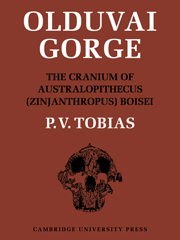Book contents
- Frontmatter
- Contents
- List of text-figures
- List of plates
- List of tables
- Introductory Note
- Foreword
- Editor's Note
- Acknowledgements
- I Introduction
- II Preservation and reconstruction of the cranium
- III The cranial vault
- IV The basis cranii externa
- V Certain critical angles and indices of the cranium
- VI The interior of the calvaria
- VII The thickness of the cranial bones
- VIII The endocranial cast of Zinjanthropus
- IX Metrical characters of the calvaria as a whole
- X The structure of the face
- XI The pneumatisation of the Zinjanthropus cranium
- XII The dental arcade and the palate
- XIII The pattern of dental attrition and occlusion, with comments on enamel hypoplasia
- XIV The size of individual teeth, absolute and relative
- XV The size of the dentition as a whole
- XVI The crown shape index of the teeth
- XVII The morphology of the teeth
- XVIII Summary of cranial and dental features of Zinjanthropus
- XIX The taxonomic status of Zinjanthropus and of the australopithecines in general
- XX The cultural and phylogenetic status of Australopithecus boisei and of the australopithecines in general
- References
- Index of persons
- Index of subjects
- Plate section
XIII - The pattern of dental attrition and occlusion, with comments on enamel hypoplasia
Published online by Cambridge University Press: 05 November 2011
- Frontmatter
- Contents
- List of text-figures
- List of plates
- List of tables
- Introductory Note
- Foreword
- Editor's Note
- Acknowledgements
- I Introduction
- II Preservation and reconstruction of the cranium
- III The cranial vault
- IV The basis cranii externa
- V Certain critical angles and indices of the cranium
- VI The interior of the calvaria
- VII The thickness of the cranial bones
- VIII The endocranial cast of Zinjanthropus
- IX Metrical characters of the calvaria as a whole
- X The structure of the face
- XI The pneumatisation of the Zinjanthropus cranium
- XII The dental arcade and the palate
- XIII The pattern of dental attrition and occlusion, with comments on enamel hypoplasia
- XIV The size of individual teeth, absolute and relative
- XV The size of the dentition as a whole
- XVI The crown shape index of the teeth
- XVII The morphology of the teeth
- XVIII Summary of cranial and dental features of Zinjanthropus
- XIX The taxonomic status of Zinjanthropus and of the australopithecines in general
- XX The cultural and phylogenetic status of Australopithecus boisei and of the australopithecines in general
- References
- Index of persons
- Index of subjects
- Plate section
Summary
Attrition of individual teeth
Although the M3's of Zinjanthropus are not fully erupted, the other teeth are already markedly worn with one or more areas of exposed dentine on every one. Such early wear is characteristic of the Australopithecinae. The degree of wear may be compared with that in South African australopithecine maxillae, of which two specimens of Australopithecus (Sts 52 a and Sts 37) and four specimens of Paranthropus (the Kromdraai specimen, SK 13, SK 52 and SK 49) have the M3's not fully erupted, some being a little more advanced and some at a slightly earlier stage of eruption than Zinjanthropus: in all these maxillae, the amount of attrition is far less than in Zinjanthropus. The degree of attrition in the latter has already levelled the cusps and left numerous areas of dentine exposure (pl. 29). The exposed dentine is black in colour, in contrast with the yellowish-grey enamel. Areas of exposure are thus particularly clearly delimited.
The incisors have a substantial strip of exposed dentine, extending for the full mesiodistal diameter of the teeth, save for the mesial and distal enamel walls (pl. 32). Wear is slightly greater on the right I than on the left, the incisal surface being hollowed on the former, but straight to convex on the latter. The canines show the typically hominid form of wear from the tip (cf. Le Gros Clark, 1950a), which has resulted in a nearly flat occlusal surface with an irregularly biconvex area of dentine exposure, somewhat larger on the right canine than on the left.
- Type
- Chapter
- Information
- Olduvai Gorge , pp. 139 - 143Publisher: Cambridge University PressPrint publication year: 1967



